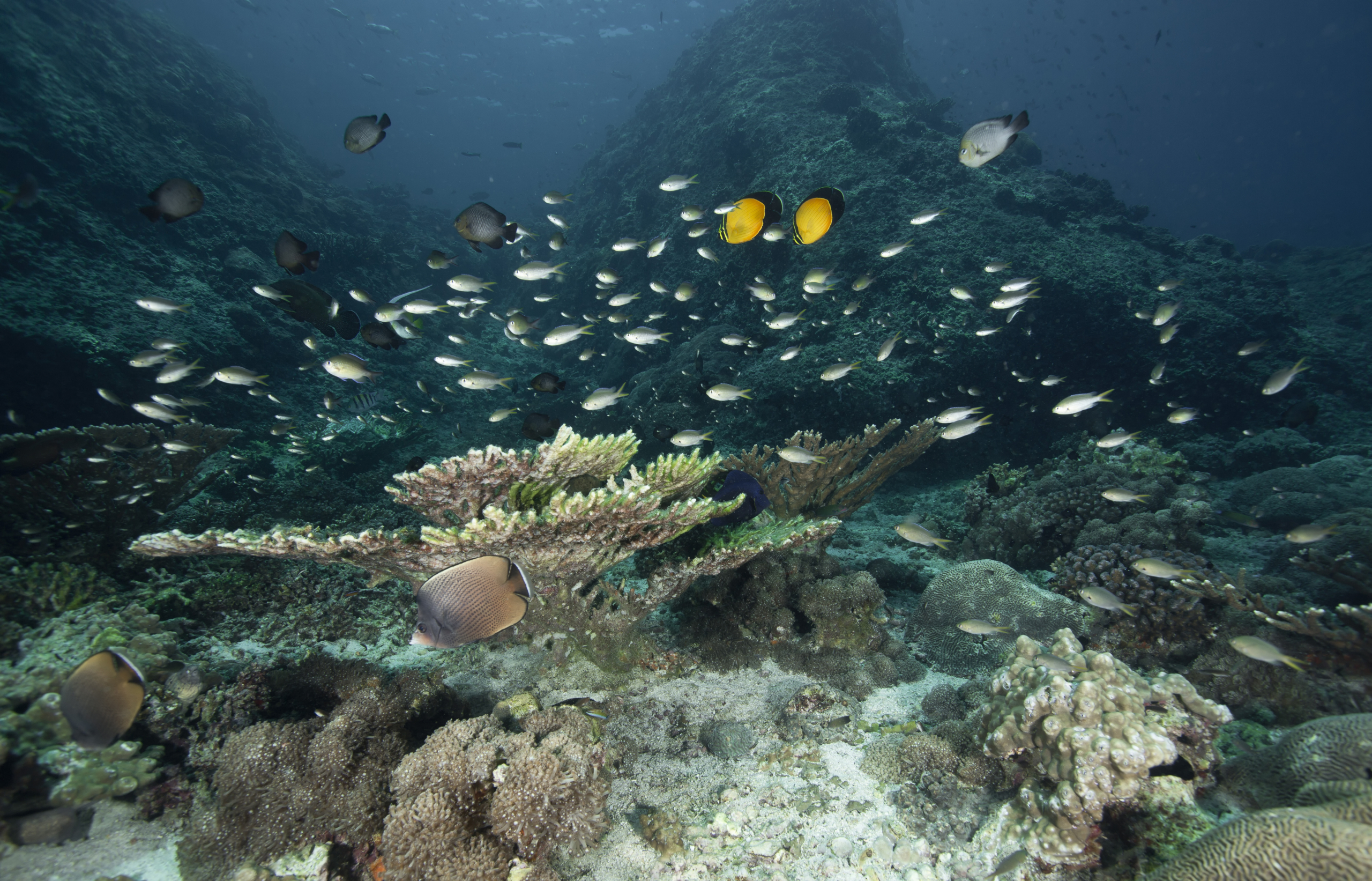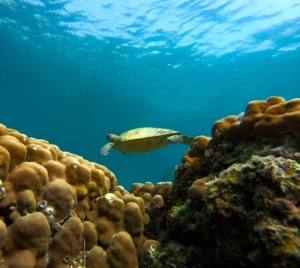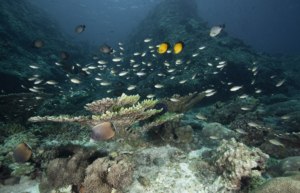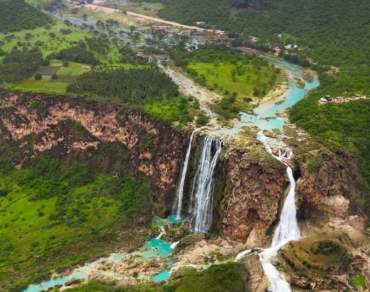
-
Oman Tour Packages > Blog > Hidden Treasures: The Best Spots for Scuba Diving Oman’s Crystal Waters

Hidden Treasures: The Best Spots for Scuba Diving Oman’s Crystal Waters
Oman’s impressive 3,000-kilometer coastline gives underwater explorers access to some of the world’s most nutrient-rich waters. The conditions are perfect to explore vibrant coral reefs and marine life, with visibility up to 30 meters and water temperatures between 19-28°C.
The remarkable biodiversity makes Scuba Diving in Oman. You can spot 22 species of whales and dolphins, including sperm whales, humpbacks, and orcas. The UNESCO-listed Daymaniyat Islands stand out as the country’s premier diving location, which features protected turtle nesting beaches and thriving coral formations.
In this piece, we’ll take a closer look at the best diving spots in Oman’s crystal-clear waters, from the famous Daymaniyat Islands to the historic Al Munassir wreck. You’ll learn about seasonal wildlife encounters and get practical tips to plan your underwater adventure.
Top Diving Destinations in Muscat
The crystal waters near Muscat are home to three amazing diving spots. Each location gives divers a chance to experience something special underwater. Let’s take a closer look at these spots that make Oman’s scuba diving experience unmatched.
Daymaniyat Islands Nature Reserve is Oman’s top marine sanctuary, just 18 kilometers off the Batinah Coast. This protected group of nine islands has 12 different dive sites. The islands have some of Oman’s richest coral cover that grows down to 20 meters. The water here is clearer than any other coral area in Oman. Divers often see large groups of whale sharks from July to late September. Water temperatures range from 23°C in winter to 32°C in summer.
Fahal Island, also known as Shark Island, sits 4 kilometers from the mainland of Muscat. This limestone structure dates back 35-55 million years and houses all but three of the 39 coral species you’ll find in the Muscat area. The island features several dive sites:
 Lesser-Known Diving Spots
We found some amazing hidden gems in Oman’s northern and southern regions that go beyond the popular diving spots near Muscat. These quiet spots are a great way to get underwater experiences that match their famous counterparts.
Hidden coves of Musandam. The UAE separates the rugged Musandam Peninsula from mainland Oman, and it holds 23 beautiful dive sites. Summer water temperatures reach 28-30°C while winter sees 21-24°C. These nutrient-rich waters support lots of marine life. The area’s signature purple corals, which you’ll only find in Omani waters, stand out.
The Caves Island shines as an advanced-level diving spot among Musandam’s treasures. We explored Ras Sannat’s dramatic underwater caves shaped by sea erosion. Stingrays and sharks often rest on the sandy bottom here. These natural formations are home to large schools of goldfish and shrimp colonies.
Lima Rocks is a chance to see something special with its limestone formations. Deep waters let divers spot 2.5-meter-long nurse sharks and devil rays around hard coral formations. Khor Hablain gives you a quieter experience where coral gardens host barracudas, rays, and sea turtles.
Salalah’s pristine reefs sit about 1,000 kilometers south of Muscat and show a completely different underwater world. The Khuriya Muriya Islands (Al Hallaniyat Islands) lie 40 kilometers off the coast with barely touched dive sites.
These waters are special because hard coral and kelp forests live side by side. Kelp forests grow up to 10 meters long next to coral reefs during summer. You’ll find this ecosystem in just a few places worldwide. All the same, these kelp forests naturally shrink by September.
The marine life here is different from northern waters. We came across huge moray eels, including the dragon moray eel that lives only in Omani waters. Large schools of fish like grunts, sweetlips, and sweepers swim around, barely noticing divers.
Salalah’s diving season runs in the dry winter months because summer monsoons bring rough seas and strong currents. October through May gives you the best time to explore, with calm seas and perfect water temperatures.
Lesser-Known Diving Spots
We found some amazing hidden gems in Oman’s northern and southern regions that go beyond the popular diving spots near Muscat. These quiet spots are a great way to get underwater experiences that match their famous counterparts.
Hidden coves of Musandam. The UAE separates the rugged Musandam Peninsula from mainland Oman, and it holds 23 beautiful dive sites. Summer water temperatures reach 28-30°C while winter sees 21-24°C. These nutrient-rich waters support lots of marine life. The area’s signature purple corals, which you’ll only find in Omani waters, stand out.
The Caves Island shines as an advanced-level diving spot among Musandam’s treasures. We explored Ras Sannat’s dramatic underwater caves shaped by sea erosion. Stingrays and sharks often rest on the sandy bottom here. These natural formations are home to large schools of goldfish and shrimp colonies.
Lima Rocks is a chance to see something special with its limestone formations. Deep waters let divers spot 2.5-meter-long nurse sharks and devil rays around hard coral formations. Khor Hablain gives you a quieter experience where coral gardens host barracudas, rays, and sea turtles.
Salalah’s pristine reefs sit about 1,000 kilometers south of Muscat and show a completely different underwater world. The Khuriya Muriya Islands (Al Hallaniyat Islands) lie 40 kilometers off the coast with barely touched dive sites.
These waters are special because hard coral and kelp forests live side by side. Kelp forests grow up to 10 meters long next to coral reefs during summer. You’ll find this ecosystem in just a few places worldwide. All the same, these kelp forests naturally shrink by September.
The marine life here is different from northern waters. We came across huge moray eels, including the dragon moray eel that lives only in Omani waters. Large schools of fish like grunts, sweetlips, and sweepers swim around, barely noticing divers.
Salalah’s diving season runs in the dry winter months because summer monsoons bring rough seas and strong currents. October through May gives you the best time to explore, with calm seas and perfect water temperatures.
 Marine Life Encounters
Oman’s waters teem with extraordinary marine life that makes every dive a remarkable encounter. Different species create an ever-changing underwater spectacle throughout the year that keeps divers coming back for more.
Seasonal whale shark migrations: These gentle giants of Oman’s waters follow predictable patterns that amaze divers year after year. Whale sharks start appearing between July and November and gather in impressive numbers. September and October give the best chances to spot them. The nutrient-rich waters around the Daymaniyat Islands and the Musandam Peninsula attract these magnificent creatures. Plankton blooms in these areas often draw groups of 10 or more individuals. Researchers have identified 174 whale sharks in Omani waters since 2010, with 58 documented in Musandam and 115 around the Daymaniyat Islands.
Turtle nesting sites in Oman stand without doubt as one of the world’s best turtle sanctuaries. The country’s beaches welcome five of the world’s seven sea turtle species. These species make Oman’s beaches their nesting grounds:
Marine Life Encounters
Oman’s waters teem with extraordinary marine life that makes every dive a remarkable encounter. Different species create an ever-changing underwater spectacle throughout the year that keeps divers coming back for more.
Seasonal whale shark migrations: These gentle giants of Oman’s waters follow predictable patterns that amaze divers year after year. Whale sharks start appearing between July and November and gather in impressive numbers. September and October give the best chances to spot them. The nutrient-rich waters around the Daymaniyat Islands and the Musandam Peninsula attract these magnificent creatures. Plankton blooms in these areas often draw groups of 10 or more individuals. Researchers have identified 174 whale sharks in Omani waters since 2010, with 58 documented in Musandam and 115 around the Daymaniyat Islands.
Turtle nesting sites in Oman stand without doubt as one of the world’s best turtle sanctuaries. The country’s beaches welcome five of the world’s seven sea turtle species. These species make Oman’s beaches their nesting grounds:
 Conclusion
Oman’s crystal waters are a chance to experience underwater adventures that match the world’s best diving spots. Our time there showed us pristine reefs full of life, from whale shark gatherings at Daymaniyat Islands to the unique kelp forests of Salalah.
These waters have something special for every diver. Beginners can tuck into the gentle slopes of Bandar Khayran, and advanced divers will love the challenges in Musandam’s dramatic underwater caves. Each dive brings new rewards with remarkable biodiversity that includes five sea turtle species and over 280 types of fish.
Good planning is key to great diving adventures in Oman. Weather patterns substantially affect diving conditions in different regions. The best time to dive is between April and October when visibility is clear and temperatures are just right. You’ll need proper permits and certifications before you can explore these underwater treasures.
The massive whale shark gatherings and hidden coral gardens make Oman’s waters a constant source of amazement. Their untouched beauty and rich marine life are still unknown to many divers. These pristine spots deserve their place among the world’s finest underwater destinations. Dive into the depths of Oman’s stunning waters, explore vibrant coral reefs, exotic marine life, and a whole new underwater world. Book now!
Conclusion
Oman’s crystal waters are a chance to experience underwater adventures that match the world’s best diving spots. Our time there showed us pristine reefs full of life, from whale shark gatherings at Daymaniyat Islands to the unique kelp forests of Salalah.
These waters have something special for every diver. Beginners can tuck into the gentle slopes of Bandar Khayran, and advanced divers will love the challenges in Musandam’s dramatic underwater caves. Each dive brings new rewards with remarkable biodiversity that includes five sea turtle species and over 280 types of fish.
Good planning is key to great diving adventures in Oman. Weather patterns substantially affect diving conditions in different regions. The best time to dive is between April and October when visibility is clear and temperatures are just right. You’ll need proper permits and certifications before you can explore these underwater treasures.
The massive whale shark gatherings and hidden coral gardens make Oman’s waters a constant source of amazement. Their untouched beauty and rich marine life are still unknown to many divers. These pristine spots deserve their place among the world’s finest underwater destinations. Dive into the depths of Oman’s stunning waters, explore vibrant coral reefs, exotic marine life, and a whole new underwater world. Book now!
- Ray Bay (6-20m)
- Hamburger Bay (6-24m)
- North Point (21-30m)
- East Bay (5-18m)
- South Point (5-18m)
 Lesser-Known Diving Spots
We found some amazing hidden gems in Oman’s northern and southern regions that go beyond the popular diving spots near Muscat. These quiet spots are a great way to get underwater experiences that match their famous counterparts.
Hidden coves of Musandam. The UAE separates the rugged Musandam Peninsula from mainland Oman, and it holds 23 beautiful dive sites. Summer water temperatures reach 28-30°C while winter sees 21-24°C. These nutrient-rich waters support lots of marine life. The area’s signature purple corals, which you’ll only find in Omani waters, stand out.
The Caves Island shines as an advanced-level diving spot among Musandam’s treasures. We explored Ras Sannat’s dramatic underwater caves shaped by sea erosion. Stingrays and sharks often rest on the sandy bottom here. These natural formations are home to large schools of goldfish and shrimp colonies.
Lima Rocks is a chance to see something special with its limestone formations. Deep waters let divers spot 2.5-meter-long nurse sharks and devil rays around hard coral formations. Khor Hablain gives you a quieter experience where coral gardens host barracudas, rays, and sea turtles.
Salalah’s pristine reefs sit about 1,000 kilometers south of Muscat and show a completely different underwater world. The Khuriya Muriya Islands (Al Hallaniyat Islands) lie 40 kilometers off the coast with barely touched dive sites.
These waters are special because hard coral and kelp forests live side by side. Kelp forests grow up to 10 meters long next to coral reefs during summer. You’ll find this ecosystem in just a few places worldwide. All the same, these kelp forests naturally shrink by September.
The marine life here is different from northern waters. We came across huge moray eels, including the dragon moray eel that lives only in Omani waters. Large schools of fish like grunts, sweetlips, and sweepers swim around, barely noticing divers.
Salalah’s diving season runs in the dry winter months because summer monsoons bring rough seas and strong currents. October through May gives you the best time to explore, with calm seas and perfect water temperatures.
Lesser-Known Diving Spots
We found some amazing hidden gems in Oman’s northern and southern regions that go beyond the popular diving spots near Muscat. These quiet spots are a great way to get underwater experiences that match their famous counterparts.
Hidden coves of Musandam. The UAE separates the rugged Musandam Peninsula from mainland Oman, and it holds 23 beautiful dive sites. Summer water temperatures reach 28-30°C while winter sees 21-24°C. These nutrient-rich waters support lots of marine life. The area’s signature purple corals, which you’ll only find in Omani waters, stand out.
The Caves Island shines as an advanced-level diving spot among Musandam’s treasures. We explored Ras Sannat’s dramatic underwater caves shaped by sea erosion. Stingrays and sharks often rest on the sandy bottom here. These natural formations are home to large schools of goldfish and shrimp colonies.
Lima Rocks is a chance to see something special with its limestone formations. Deep waters let divers spot 2.5-meter-long nurse sharks and devil rays around hard coral formations. Khor Hablain gives you a quieter experience where coral gardens host barracudas, rays, and sea turtles.
Salalah’s pristine reefs sit about 1,000 kilometers south of Muscat and show a completely different underwater world. The Khuriya Muriya Islands (Al Hallaniyat Islands) lie 40 kilometers off the coast with barely touched dive sites.
These waters are special because hard coral and kelp forests live side by side. Kelp forests grow up to 10 meters long next to coral reefs during summer. You’ll find this ecosystem in just a few places worldwide. All the same, these kelp forests naturally shrink by September.
The marine life here is different from northern waters. We came across huge moray eels, including the dragon moray eel that lives only in Omani waters. Large schools of fish like grunts, sweetlips, and sweepers swim around, barely noticing divers.
Salalah’s diving season runs in the dry winter months because summer monsoons bring rough seas and strong currents. October through May gives you the best time to explore, with calm seas and perfect water temperatures.
 Marine Life Encounters
Oman’s waters teem with extraordinary marine life that makes every dive a remarkable encounter. Different species create an ever-changing underwater spectacle throughout the year that keeps divers coming back for more.
Seasonal whale shark migrations: These gentle giants of Oman’s waters follow predictable patterns that amaze divers year after year. Whale sharks start appearing between July and November and gather in impressive numbers. September and October give the best chances to spot them. The nutrient-rich waters around the Daymaniyat Islands and the Musandam Peninsula attract these magnificent creatures. Plankton blooms in these areas often draw groups of 10 or more individuals. Researchers have identified 174 whale sharks in Omani waters since 2010, with 58 documented in Musandam and 115 around the Daymaniyat Islands.
Turtle nesting sites in Oman stand without doubt as one of the world’s best turtle sanctuaries. The country’s beaches welcome five of the world’s seven sea turtle species. These species make Oman’s beaches their nesting grounds:
Marine Life Encounters
Oman’s waters teem with extraordinary marine life that makes every dive a remarkable encounter. Different species create an ever-changing underwater spectacle throughout the year that keeps divers coming back for more.
Seasonal whale shark migrations: These gentle giants of Oman’s waters follow predictable patterns that amaze divers year after year. Whale sharks start appearing between July and November and gather in impressive numbers. September and October give the best chances to spot them. The nutrient-rich waters around the Daymaniyat Islands and the Musandam Peninsula attract these magnificent creatures. Plankton blooms in these areas often draw groups of 10 or more individuals. Researchers have identified 174 whale sharks in Omani waters since 2010, with 58 documented in Musandam and 115 around the Daymaniyat Islands.
Turtle nesting sites in Oman stand without doubt as one of the world’s best turtle sanctuaries. The country’s beaches welcome five of the world’s seven sea turtle species. These species make Oman’s beaches their nesting grounds:
- Green turtles
- Hawksbill turtles
- Loggerhead turtles
- Olive Ridley turtles
- Leatherback turtles (seen only during dives)
- April-May and September-October: Perfect mix of surface and sea temperatures
- July-September: Best time to see whale sharks
- October-May: Visibility reaches up to 30 meters
- December-February: Waters are cooler (18-25°C) with crystal clear views
- E-Learning materials for diving theory
- Five confined water dives in a swimming pool
- Four open water dives
- Swim 200 meters without help
- Tread water for 10 minutes
- Be in good physical shape. You must also be at least 10 years old.
- Get permits to dive outside marine protected areas
- Talk to the Coast Guard before night dives
- Not using spear-guns while diving
- Have qualified diving crews trained in first aid
 Conclusion
Oman’s crystal waters are a chance to experience underwater adventures that match the world’s best diving spots. Our time there showed us pristine reefs full of life, from whale shark gatherings at Daymaniyat Islands to the unique kelp forests of Salalah.
These waters have something special for every diver. Beginners can tuck into the gentle slopes of Bandar Khayran, and advanced divers will love the challenges in Musandam’s dramatic underwater caves. Each dive brings new rewards with remarkable biodiversity that includes five sea turtle species and over 280 types of fish.
Good planning is key to great diving adventures in Oman. Weather patterns substantially affect diving conditions in different regions. The best time to dive is between April and October when visibility is clear and temperatures are just right. You’ll need proper permits and certifications before you can explore these underwater treasures.
The massive whale shark gatherings and hidden coral gardens make Oman’s waters a constant source of amazement. Their untouched beauty and rich marine life are still unknown to many divers. These pristine spots deserve their place among the world’s finest underwater destinations. Dive into the depths of Oman’s stunning waters, explore vibrant coral reefs, exotic marine life, and a whole new underwater world. Book now!
Conclusion
Oman’s crystal waters are a chance to experience underwater adventures that match the world’s best diving spots. Our time there showed us pristine reefs full of life, from whale shark gatherings at Daymaniyat Islands to the unique kelp forests of Salalah.
These waters have something special for every diver. Beginners can tuck into the gentle slopes of Bandar Khayran, and advanced divers will love the challenges in Musandam’s dramatic underwater caves. Each dive brings new rewards with remarkable biodiversity that includes five sea turtle species and over 280 types of fish.
Good planning is key to great diving adventures in Oman. Weather patterns substantially affect diving conditions in different regions. The best time to dive is between April and October when visibility is clear and temperatures are just right. You’ll need proper permits and certifications before you can explore these underwater treasures.
The massive whale shark gatherings and hidden coral gardens make Oman’s waters a constant source of amazement. Their untouched beauty and rich marine life are still unknown to many divers. These pristine spots deserve their place among the world’s finest underwater destinations. Dive into the depths of Oman’s stunning waters, explore vibrant coral reefs, exotic marine life, and a whole new underwater world. Book now! Related Tours
Related Tours
Test2
© 2025 Oman Tour Packages. All rights reserved.



